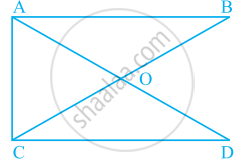Advertisements
Advertisements
Question
Can we have two obtuse angles whose sum is a complete angle? Why or why not?
Solution
No, ∵ The sum of two obtuse angles is greater than 180° but less than 360°. In the above example, we can see that the sum of 135° and 100° i.e., 235° is greater than 180° but less than 360°.
APPEARS IN
RELATED QUESTIONS
How many diagonals does following have?
A convex quadrilateral
What is the sum of the measures of the angels of a convex quadrilateral? Will this property hold if the quadrilateral is not convex? (Make a non-convex quadrilateral and try!)
Complete of the following, so as to make a true statement:
In a quadrilateral the point of intersection of the diagonals lies in .... of the quadrilateral.
In a quadrilateral ABCD, CO and DO are the bisectors of ∠C and ∠D respectively. Prove that \[∠COD = \frac{1}{2}(∠A + ∠B) .\]
In the given figure, PQRS is an isosceles trapezium. Find x and y.

If one angle of a cyclic quadrilateral is 75°, then the opposite angle is
If bisectors of ∠A and ∠B of a quadrilateral ABCD intersect each other at P, of ∠B and ∠C at Q, of ∠C and ∠D at R and of ∠D and ∠A at S, then PQRS is a ______.
ABCD is a quadrilateral in which AB || DC and AD = BC. Prove that ∠A = ∠B and ∠C = ∠D.
If a bicycle wheel has 48 spokes, then the angle between a pair of two consecutive spokes is ______.
The number of straight angles in figure is ______.
